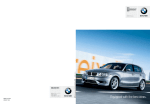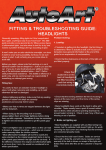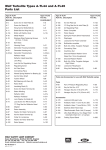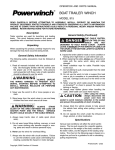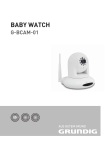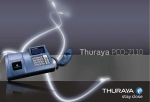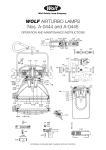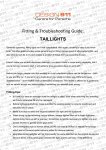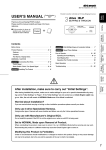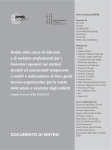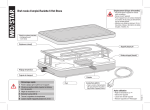Download FITTING & TROUBLESHOOTING GUIDE: SIDE REPEATERS
Transcript
FITTING & TROUBLESHOOTING GUIDE: SIDE REPEATERS Generally speaking, fitting lights isn’t that complicated; then again, anything’s easy if you know how! This little guide provides some general tips for fitting various types of aftermarket lights, and also what to look for to try and resolve a problem if things don’t go according to plan. It won’t make you an auto electrician overnight, nor does it claim to cover every possibility, but if you’re not sure where to start, it will certainly give you some ideas to work with. Before you begin, please note that working on a car’s electrical system can be dangerous – both to you and the car. If you are in any doubt about your ability to follow any of the techniques detailed below – don’t! Rather seek professional assistance. This leaflet is offered as a guide only, and we cannot accept any responsibility if something you attempt goes wrong. Side Repeater with screw fitment Fitting tips: • Most side repeaters are easy to remove and don’t require a great deal of force. Some of the early BMW side repeaters have a single retaining screw which must be reSide Repeaters showing moved, and the spring clip (A) and fixed clip (B) other side of the repeater unclipped from the wing, but almost all current side repeaters have a fixed clip on one side and a spring clip (either metal or plastic) on the other. The repeater is removed by pushing it in the direction of the spring clip (i.e. from the fixed clip side). This allows the spring clip to compress, and the fixed clip then releases from the wing so the repeater can be pulled gently outwards and removed. Sequence showing removal of a typical side repeater: 1 1. Push in direction of spring clip; 2 2. When fixed clip disengages, pull side repeater outward; 3 3. Remove side repeater from wing Side repeater bulbholder removal • Have a look at the new repeaters you want to fit before you remove the old ones, so you can see where the spring clip is and in which direction you need to push the repeater to remove it. • If the repeater is too tight to move easily by hand, use a large flat-bladed screwdriver, but wrap a soft cloth round the tip several times so that the chance of scratching or damaging anything is minimized. Side repeater testing via time-honoured method • Always remember - excessive force should not be required. If you’re applying lots of pressure and nothing’s happening, stop and make sure you’re pushing in the right direction before you break something! Problem Solving: Side repeater bulbholder & o-ring 1. Leaking: • If moisture is getting into the side repeater, the first thing is to determine if there is actually a leak or if it’s just condensation (see under general for an explanation of condensation). • The side repeater should be removed from the car and the bulbholder taken off. • To test the side repeater for leakage, you have two options: Either fill it with water and hold it bulbholder side up to see if any escapes; or place your lips over the bulbholder - clean the side repeater thoroughly first, we don’t want you getting an STD (side repeater transmitted disease) – and sealing the holder off with your mouth, blow into the repeater to see if any air comes out anywhere. • If either of the above tests prove negative, the side repeater itself is not faulty, and the problem is either just condensation or a problem with the seal/o-ring between the bulbholder and the repeater. The basic scientific explanation is this: There is always some moisture in the air, and warm air can hold more mois• Check the bulbholder and ensure that ture than cold air. When the air inside it is not damaged in any way, that it fits the light unit – which is warmed by the the repeater securely (and has been fit- heat from the bulbs – touches the inted correctly and turned all the way until side of the lens (which is at a lower it locks - but don’t overtighten as damtemperature because it is in contact age can result) and that the o-ring/ seal with the colder air outside), the layer of is not damaged or missing. air against the inside of the lens cools down as well, and as a result it can no longer retain the moisture it is holding, 2. Item doesn’t fit: which is deposited on the inside of the lens to form condensation. • This is usually because you have the wrong part for the car (doh!), either be- The condensation will only disappear cause it has been ordered or supplied once the air inside the light unit warms incorrectly. Double check the fitment up enough to absorb the moisture details in the catalogue listing and con- again, and in winter this can take some tact your dealer for clarification if you’re time. unsure. Condensation is NOT indicative of a fault with a light unit, and as such it isn’t GENERAL INFORMATION accepted as a reason for a warranty return. • Know your left from your right: References to left-hand & right-hand are as Condensation occurs in original equipviewed by someone sitting in the ment lights as well, but aftermarket driver’s seat. lights often have clear lenses without any patterns, so the condensation is • What exactly IS condensation? Con- more obvious. On a patterned original densation is caused by water vapour in equipment lens it might not be visible at the air. The moisture on the windows in- all unless one looks closely. side your house in winter is condensation – and when that happens, you don’t start looking for leaks in your windows do you? (You’ll be a long time if While the above information is offered in good you do). In exactly the same way, con- faith and is believed to be correct, neither AutoArt nor any of its dealers can accept any redensation inside a light unit is hardly sponsibility for any consequences, howsoever ever caused by a leak. caused, resulting from the application of any of the information detailed in this leaflet. Copyright 2009 AutoArt Styling Limited. Unauthorised duplication/distribution prohibited.





